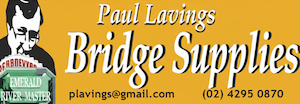This is a demo store. No orders will be fulfilled.
Effective Overcalls
Knowing what to do after your right hand opponent (RHO) opens is crucial.
An exciting and new audio-visual and interactive teaching method from Marty Bergen.
Marty's audio visual format significantly enhances your learning experience:
- The combination of voice and visual effects makes it easier to understand what Marty is teaching.
- The lesson is interactive, so students "learn by doing."
- You can proceed at your own pace.
- You can play and replay all or some of the lesson whenever you choose as many times as you like.
- The lesson includes a written easy to read transcript for you to study.
- The lesson contains several hours of extensive material.
- The lesson is designed to work on most popular computers and browsers, including Windows, Mac, and iPad.
Approximate running time of this lesson: 110 minutes.
In this lesson:
On 50% of the deals you play, the player who opens the bidding is your opponent. When that opponent is your RHO, the player in the hot seat is YOU.
When your side opens the bidding, HCP play a very significant role in your decision-making. But, things are very different when the enemy bids first. When your RHO opens, HCP are no longer the key. Level, distribution, vulnerability, suit quality and your holding in RHO's suit are now more important.
Marty will discuss the following topics:
- - Why you should be super-aggressive after your RHO opens 1♣
- - When to pass a strong hand
- - Very flexible takeout doubles
- - 1-level overcalls: All you need is a reason
- - 1NT Overcalls: Very descriptive
- - 2-level overcalls: 6-card suits are the norm
- - Two-suited overcalls: Some are better than others
- - Jump Overcalls: How aggressive should you be
Here is an example of what Marty will discuss in the lesson:
Neither side is vulnerable.
You hold: ♠32 ♥K1054 ♦KQ6 ♣AQ97
You right hand opponent opens 1♦. What is your call?
Answer: Bid 1NT.
I know that you have only 14 HCP, and I'm not asking you to lie. But when your side is not vulnerable, I strongly recommend defining a 1NT overcall as 14-17 HCP. This modest change will allow you to take action with many hands that otherwise would have forced you to pass.
When you are the dealer and have a good hand, if you don't have a perfect bid, you can always open a minor. That luxury is not available when an opponent opens. That's all the more reason to make it easier for your side to compete by lowering the traditional requirements for 1NT overcalls.
An exciting and new audio-visual and interactive teaching method from Marty Bergen.
Marty's audio visual format significantly enhances your learning experience:
- The combination of voice and visual effects makes it easier to understand what Marty is teaching.
- The lesson is interactive, so students "learn by doing."
- You can proceed at your own pace.
- You can play and replay all or some of the lesson whenever you choose as many times as you like.
- The lesson includes a written easy to read transcript for you to study.
- The lesson contains several hours of extensive material.
- The lesson is designed to work on most popular computers and browsers, including Windows, Mac, and iPad.
Approximate running time of this lesson: 110 minutes.
| Platform | Any browser |
|---|







